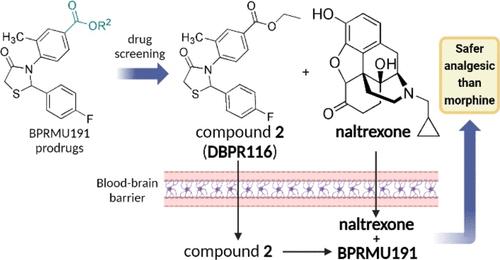DBPR116(BPRMU191 的一种原药)与纳曲酮联用是一种比外周给药吗啡更安全的阿片类镇痛药
IF 5.3
2区 材料科学
Q2 MATERIALS SCIENCE, MULTIDISCIPLINARY
引用次数: 0
摘要
开发可减少不良反应的阿片类镇痛药是一项尚未满足的需求。在之前的一项研究中,我们发现了一种独特的 BPRMU191 和吗啡酮拮抗剂组合,这种组合在中枢给药(鞘内或脑室内)后可产生强效抗镇痛作用并减少不良反应。BPRMU191/naltrexone 具有显著的体外和体内药理特性。然而,BPRMU191 的血脑屏障穿透能力较差,限制了其临床应用。在本研究中,我们利用原药策略来提供足够浓度的 BPRMU191,并在其他体内活性原药中选择了理化和药理特性最佳的化合物 2(DBPR116)。化合物 2/naltrexone 的体内药理研究,包括热刺激痛、癌痛、便秘、镇静、心理依赖、心率和呼吸频率测量,证明它是一种比吗啡更安全的阿片类镇痛药。本文章由计算机程序翻译,如有差异,请以英文原文为准。

DBPR116, a Prodrug of BPRMU191, in Combination with Naltrexone as a Safer Opioid Analgesic Than Morphine via Peripheral Administration
The development of opioid analgesics with reduced adverse effects is an unmet need. In a previous study, we discovered a unique combination of BPRMU191 and morphinan antagonists that produced potent antinociception with reduced adverse effects after central administration (intrathecal or intracerebroventricular). BPRMU191/naltrexone exhibits notable in vitro and in vivo pharmacological properties. However, the poor blood–brain barrier penetrative ability of BPRMU191 restricts its clinical application. In this study, we utilized a prodrug strategy to deliver sufficient brain concentrations of BPRMU191 and selected compound 2 (DBPR116) with the best physicochemical and pharmacological properties among other in vivo active prodrugs. The in vivo pharmacological studies of compound 2/naltrexone, including thermally stimulated pain, cancer pain, constipation, sedation, psychological dependence, heart rate, and respiratory frequency measurements, demonstrated that it was a safer opioid analgesic than morphine in pain control.
求助全文
通过发布文献求助,成功后即可免费获取论文全文。
去求助
来源期刊

ACS Applied Nano Materials
Multiple-
CiteScore
8.30
自引率
3.40%
发文量
1601
期刊介绍:
ACS Applied Nano Materials is an interdisciplinary journal publishing original research covering all aspects of engineering, chemistry, physics and biology relevant to applications of nanomaterials. The journal is devoted to reports of new and original experimental and theoretical research of an applied nature that integrate knowledge in the areas of materials, engineering, physics, bioscience, and chemistry into important applications of nanomaterials.
 求助内容:
求助内容: 应助结果提醒方式:
应助结果提醒方式:


